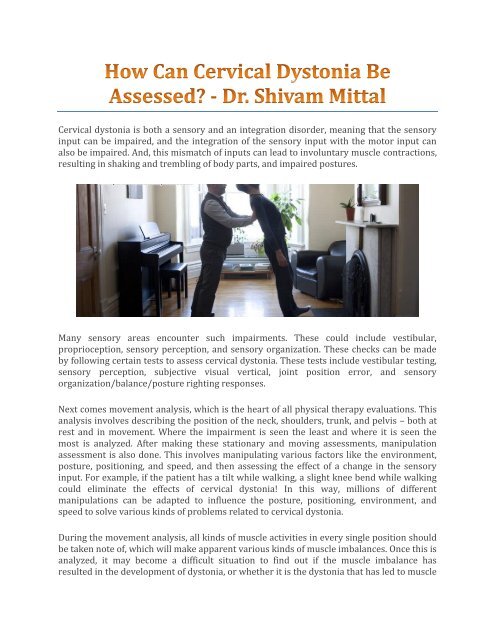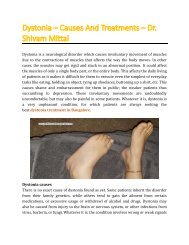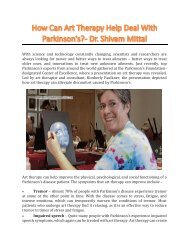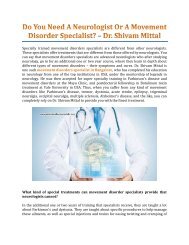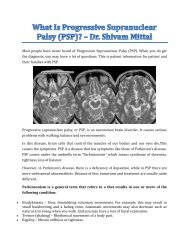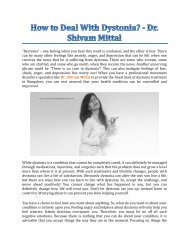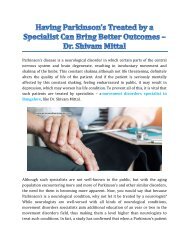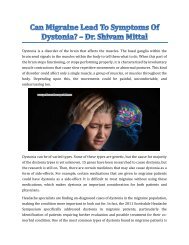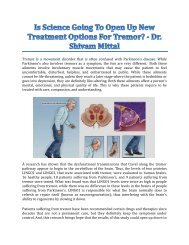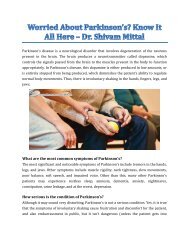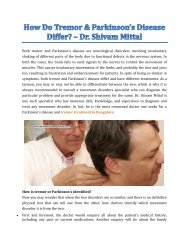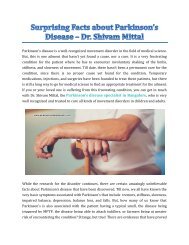How Can Cervical Dystonia Be Assessed? - Dr. Shivam Mittal
Cervical dystonia is both a sensory and an integration disorder, wherein many sensory areas can encounter impairments. There are various tests and assessments that need to be executed to analyze this ailment. Read more @ https://goo.gl/awpbAE
Cervical dystonia is both a sensory and an integration disorder, wherein many sensory areas can encounter impairments. There are various tests and assessments that need to be executed to analyze this ailment.
Read more @ https://goo.gl/awpbAE
Create successful ePaper yourself
Turn your PDF publications into a flip-book with our unique Google optimized e-Paper software.
<strong>Cervical</strong> dystonia is both a sensory and an integration disorder, meaning that the sensory<br />
input can be impaired, and the integration of the sensory input with the motor input can<br />
also be impaired. And, this mismatch of inputs can lead to involuntary muscle contractions,<br />
resulting in shaking and trembling of body parts, and impaired postures.<br />
Many sensory areas encounter such impairments. These could include vestibular,<br />
proprioception, sensory perception, and sensory organization. These checks can be made<br />
by following certain tests to assess cervical dystonia. These tests include vestibular testing,<br />
sensory perception, subjective visual vertical, joint position error, and sensory<br />
organization/balance/posture righting responses.<br />
Next comes movement analysis, which is the heart of all physical therapy evaluations. This<br />
analysis involves describing the position of the neck, shoulders, trunk, and pelvis – both at<br />
rest and in movement. Where the impairment is seen the least and where it is seen the<br />
most is analyzed. After making these stationary and moving assessments, manipulation<br />
assessment is also done. This involves manipulating various factors like the environment,<br />
posture, positioning, and speed, and then assessing the effect of a change in the sensory<br />
input. For example, if the patient has a tilt while walking, a slight knee bend while walking<br />
could eliminate the effects of cervical dystonia! In this way, millions of different<br />
manipulations can be adapted to influence the posture, positioning, environment, and<br />
speed to solve various kinds of problems related to cervical dystonia.<br />
During the movement analysis, all kinds of muscle activities in every single position should<br />
be taken note of, which will make apparent various kinds of muscle imbalances. Once this is<br />
analyzed, it may become a difficult situation to find out if the muscle imbalance has<br />
resulted in the development of dystonia, or whether it is the dystonia that has led to muscle
imbalance. While the decision to be made is difficult, it certainly needs to be made. There<br />
could also be other predisposing factors like weakness, flexibility, neural tension, breathing<br />
patterns, alignments, and other various factors. Addressing these potential factors can be of<br />
high importance.<br />
Weakness – imbalance<br />
Flexibility – cervical muscle and joint flexibility<br />
Neural tension – upper limb tension patterns<br />
Breathing patterns – upper chest breathing and diaphragmatic breathing<br />
Alignment – Pelvis, trunk, and head alignment while sitting, standing, and sleeping<br />
Is also helpful to evaluate for activities that provide immediate improvements in a cervical<br />
dystonia patient. If the patient is limited by a sensory or sensory integration abnormality,<br />
these ideas can be helpful – placing the arm over the head, change in posture, vibration on<br />
overactive muscles, Kinesiotaping, etc.<br />
<br />
<br />
<br />
<br />
<br />
There’s that! With such cervical dystonia assessment, the underlying problem can be<br />
analyzed much quicker and better. If you see any symptoms of involuntary shaking and<br />
trembling of your body parts, you can get in touch with <strong>Dr</strong>. <strong>Shivam</strong> <strong>Mittal</strong>, who is one of the<br />
most reliable and expert professional offering dystonia treatment in Bangalore. You can<br />
rest assured to be analyzed and prescribed the right kind of medication and therapies here.<br />
Stay social with us on: Facebook, Twitter, Google+, LinkedIn


